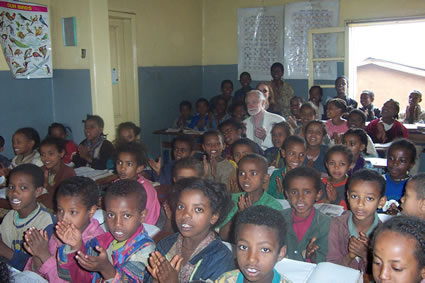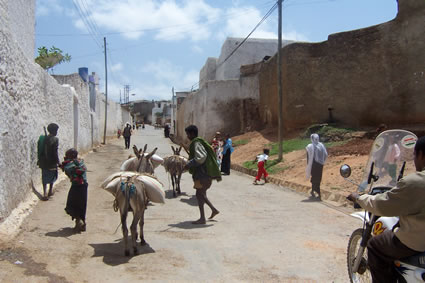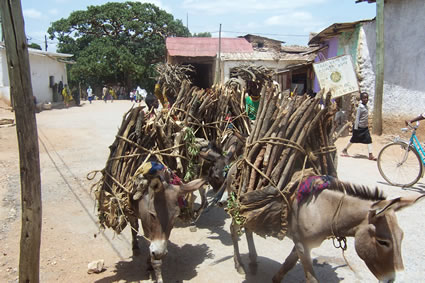Letter from Ethiopia
Visitors to Africa’s “Best-Kept Secret” Receive Rich Rewards
Article and photos by Drs. Clay and Joanna Hubbs
Addis Ababa, Ethiopia — intrigued by Chris Shinn’s report on the wonders of Ethiopia and Eritrea, we came here to see for ourselves. Chris, who was born in neighboring Kenya and has traveled the length of Africa, calls the Horn of Africa the continent’s best-kept secret and describes its major attractions. We wanted to learn more about the opportunities for cultural immersion for independent travelers coming here for the first time. With only two weeks to stay, we limited our visit to the central and northern parts of Ethiopia, with a side trip to the ancient Muslim town of Harar in the west.
Addis Ababa
Thanks to a combination of recent wars, droughts, and famines, Africa’s richest country in natural beauty and human resources is also one of its poorest. Per capita income is estimated at around $390 per year. Refugees from poverty-stricken areas of the north continue to stream into Addis looking for work, and one of the first images to hit you as you drive from the airport down Bole Road toward the center of town is overpopulation and poverty on a major scale. We found that how you respond to those who are in terrible need of food and medical help defines your stay in Ethiopia.
Obviously, you can’t give money to all who need it, so what do you do? On the advice of Ethiopian friends and foreign relief workers, we gave small sums to those on the street who were chronically ill and to mothers with babies. During our first few days in Addis we visited orphanages, schools, and families being supported by various relief agencies and gave what we could afford — and pledged more — to support their work.

Dr. Clay Hubbs with bright-eyed and beautiful children in a classroom at the Missionaries of Charity school in Addis Ababa.
|
For this issue of Transitions Abroad, with its focus on work abroad, we hoped to gather information on opportunities for volunteering. But the aid workers we talked with told us that they simply couldn’t afford to accept nonprofessionals as volunteers. Even if the volunteers were paid nothing, they would require food, accommodations, health insurance — not to mention attention.
Much better to hire Ethiopians, we were told. In fact, much better that Ethiopians constitute the entire staff when possible.
What, then, can a visitor do to assist those who need it most? The short answer is to come here and spend money. Perhaps in no place else in the world will you be better rewarded.
Tourism is thought to have the greatest growth potential of any economic activity in Ethiopia. We wanted to know what could be done to encourage tourism, given the country’s limited tourist facilities and the government’s tiny budget to support tourism. To try to find some answers we first went to see the country’s energetic and engaging commissioner of tourism, Yusuf Abdullahi Sukkar.
Yusuf’s response (in Ethiopia people
address each other by their first name, even at first meeting)
was to ask us what we wanted to see and offer to arrange for transportation
and guides for all the places we mentioned. Being determinedly
independent travelers, we made all our own arrangements with no
difficulties. However, since our time was short, it was reassuring
to know that Yusuf and his efficient staff at the Tourism Commission
double-checked to see that our plane and hotel reservations were
confirmed. (A quick plug here, too, for Ethiopian Airlines: We changed our travel plans several times, and the people who helped us were always exceptionally understanding and helpful, like everyone we met in Ethiopia. As we hopped from one town to another, we had never felt more secure on any airline — both because of the thorough security checks at every airport and the obvious skill and safety precautions taken by the pilots. Ethiopia is a big country — larger than France, Germany, and Poland combined — but transportation to the major towns is easy and relatively inexpensive by air.)

Outside the medieval walls in Harar, Ethiopia.
|
The Historical Route
Our itinerary was approximately the same as that described by Chris Shinn, minus Eritrea: Addis to Axum, Lalibela, Gondar, and Bahar Dar and Addis to Harar — a total distance of over 3,000 kilometers. We traveled to each town by air at a total cost for two of less than $500. Except for Harar, where we stayed in a quiet guesthouse outside of town for $10 for the night, we chose government-owned hotels. A van meets all guests at the airport (the pick-up service is included in the price of the hotel — approximately $50 a night). Once at the hotel, we arranged with the manager for a guide and driver and settled on the guide’s fee in advance — around $25 per day including admission fees to the museums and historical sites. You can of course travel much more cheaply by land. Backpackers do it on $10 a day.
While we usually insist on traveling on our own, Ethiopia is exceptional in its historical complexity and cultural richness. We read a number of helpful overviews and travelers’ accounts before and during our stay, but official guides — who are well-educated and well-informed members of the community — are essential to provide a context for the first-time visitor and an introduction to the homes and businesses of average Ethiopians (see below). Our first question to each of them — as well as to hotel managers and anyone else we met — was the same:
“This place is incredible. Why are there not more tourists?”
Their answers were always the same: The world, they said, seems largely ignorant of the real Ethiopia — its people, history, and culture. There are no beaches in this landlocked country and few resort hotels where the stereotypical foreign tourist can be sheltered from local conditions while being pampered at relatively little expense to them, as is the case in many underdeveloped countries. And potential visitors who would appreciate the cultural richness of the country seem largely to have been put off by the images in media.
Because alone of all the African countries Ethiopia has never been colonized — except for a brief and bloody period under Italy’s Mussolini, much of its traditional culture remains unchanged and the people deeply independent. They are also exceptionally open and welcoming to foreigners. English is spoken, at least by those with some schooling. In the towns we visited along the historical route accommodations and services were more than adequate, but we were told that off the beaten track hotels are generally not well-maintained and sometimes consist of little more than a bed in a hut with no water or electricity.
Most visitors, our informers told us, were either backpackers or participants in organized tours, who put up at the same government hotels where we stayed. However, more comfortable private hotels are being built in the major tourist stops. For independent travelers who follow Chris Shinn’s and our itinerary, accommodations and transportation are not a problem.

Donkeys carrying wood through the streets are a common sight.
|
Ecotourism
The best way to travel off the beaten track — to the outstanding natural sites in every part of Ethiopia, filled with numerous species of birds and animals that are native only to Ethiopia — is by trekking and camping. We spoke with Mark Chapman, an English resident of Addis who is heading up Ethiopia’s first community-based tourism project. The residents of Meket, a stunningly beautiful but also terribly poor area in the northern province of Wollo, not far from the ancient capital of Lalibela, have built small local-style houses to accommodate visitors. The cost per day for food, local driver, accommodations, guides, and pack animals is about US$50. The income generated will be distributed directly to the people of the community.
Charitable Organizations in Ethiopia
The organization we visited for a full day was run at the time by the extraodinarily kind Brother Abraham of what was then called Missionaries of Charity, working with Catholic Relief Services. He ran two primary schools as well as a home for disabled children in the poorest part of Addis Ababa. Missionaries of Charity, also supported a large number of families with help for basic needs. Most people in this area live in what we would call lean-tos with tin roofs letting in rain.
Our hosts suggested that if we wished to help in the development of tourism — and of the country as a whole — we should send money to charities for textbooks in English. We were touched by requests from small children, everywhere from Addis to Gondar, who pleaded for books and pens. Education is seen even by the very young as the only way out of poverty. Donations to local charities can be used to build the schools and buy the books and supplies necessary to provide the education and hope so needed by the charming, beautiful, and bright-eyed children hoping for a better future.
|
|

